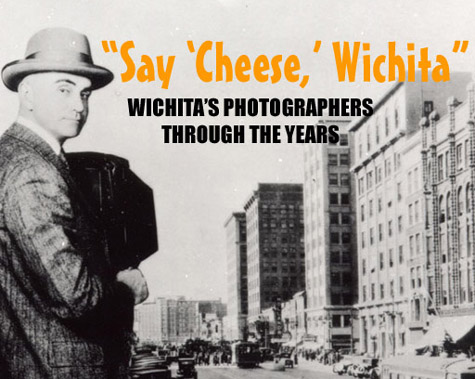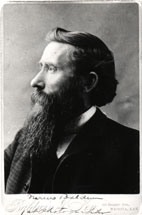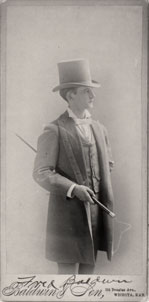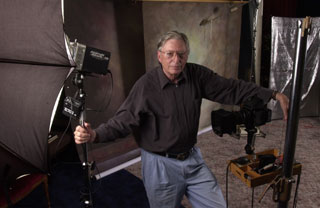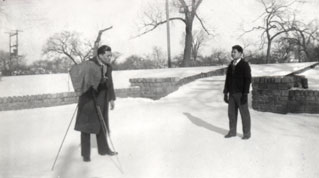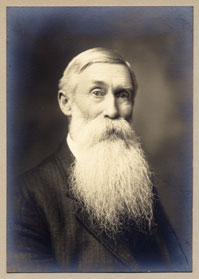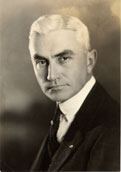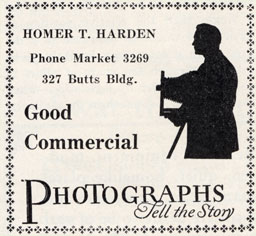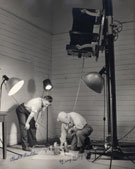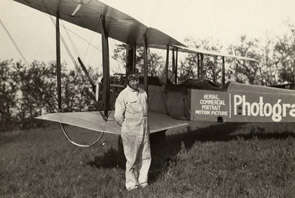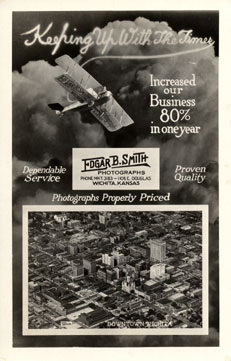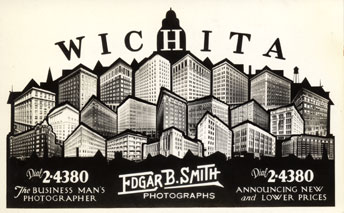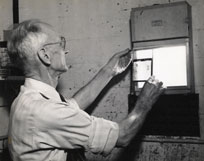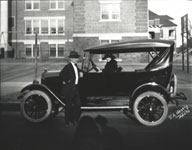This
exhibit highlights a selection of professional photographers who, for
over 130 years, have documented our
city. Examples of the featured photographers'
work are found in the Wichita Photo Archives.
Click on the links to learn more about
the following Wichita photographers:
Fred
Baldwin | Nereus Baldwin
Howard Eastwood
Mar
Suey Fong
Alden Harden | Homer T.
Harden
William S. Rogers and Guy Rogers
Edgar B. Smith
Arthur Spalton
Frank A. Wesely
|
Click on any image to view
an enlargement. Use the back arrow to return to this page.
|
|
Of Quaker descent, Nereus Baldwin was born January 8, 1840, near Dalton, Indiana. At the age of 20 he opened his first gallery in Farmland, Indiana. In 1869, Baldwin moved to Lawrence, Kansas, and operated a business there for several years. By 1873 he moved to Wichita, then a small town of just over 2000 people, and opened a gallery. Nereus Baldwin was one of the first photographers to work in Wichita. His photographic gallery was located for many years above 118 East Douglas. He photographed scenes of early Wichita, its townspeople, and of notable events. He also took stereoscopic photographs of street scenes. In the mid-1870s Baldwin opened a portion of his studio to the Wichita Public Library for offices and a library. A small collection of books was kept in the reception room of the photograph gallery, upstairs in the New York Store building. In July 1877, the circulating library moved from Baldwin's studio to the front basement room of the First National Bank Building. Baldwin's oldest son was William F. (Fred) Baldwin, another early Wichita photographer. Baldwin was in business with his son from 1886 until the time of his death. The photographic gallery called N. Baldwin & Son continued to be located at 118 East Douglas. In 1904, the local paper reports that Nereus Baldwin, along with his son Fred, had taken over 150,000 pictures since opening the gallery in 1873, with about 50,000 negatives of these images kept. Nereus Baldwin died on March 30, 1901,
and is buried in Maple Grove Cemetery in Wichita. |
|
| William F. Baldwin was
born May 31, 1866. His father was the early Wichita photographer Nereus
Baldwin. By 1886, William F., known as Fred, joined his father's studio
located on the second floor of 118 East Douglas Avenue to form N.
Baldwin & Son. In 1902, Nereus retired and Fred opened the Fred
Baldwin Studio at the same address.
In October 1905, Fred Baldwin left for San Diego, to take charge of a gallery in which he had purchased an interest. Fred H. Reed, a photographic operator working for Baldwin, was left in charge of the Wichita business. Baldwin didn't return to his studio in Wichita until April 1911. While he was away he studied in some of the leading galleries in the United States, and he made several pictures that received awards in the National Photographers' Association. Late in 1911, Baldwin sold his photographic studio to Fred H. Reed and went south for his health. Upon his return in the spring of 1912, Baldwin briefly reopened the Fred Baldwin Studio, but sold this business in October 1912 to Reed. It was consolidated with the Reed Studio. On January 13, 1913, Fred Baldwin died of consumption
in Silver City, New Mexico. He is buried in Maple Grove Cemetery
in Wichita. |
|
Wichita photographer Howard Eastwood began his career
in photography at an early age with a Kodak Baby Brownie camera.
From 1954 until 1955 Eastwood worked as a photographer for the Wichita
Eagle. Starting his own studio out of his home, he later established
the Eastwood Studio in the Twin Lakes Shopping Center and, later,
in the Indian Hills Shopping Center. He would remain there until
his retirement in 2001. Eastwood's collection of portraits and cityscapes
span almost 50 years of Wichita's history. Photograph at left courtesy of the Wichita Eagle. |
|
During the 1920s, many Chinese men immigrated to the
United States. Those who arrived in Wichita established restaurants
that employed the next generation of immigrants in the 1930s. M. S.
Fong was one such young man who supported himself in the restaurant
trade but also followed his ambition to become a photographer and
an artist. He arrived in Wichita in the mid-1930s at about the age of 18. He worked at the Chinese-owned Pan American Café until 1940, at which time he purchased a share as co-owner of the Fairland Café which had recently changed its name from the Mandarin Inn. His involvement with the popular Fairland Café lasted until 1969. Throughout his life, however, he continued his photography. In his early years in Wichita he practiced his skills on his fellow Chinese co-workers and several examples of those photographs remain. There is evidence that he operated the Wichita Studio at 411 East Douglas Avenue in 1940 and 1941. Later, he maintained a photographic studio in his home from 1952-1962. View images of and by Fong in Wichita Photo Archives. |
| Alden Wakefield Harden was born in Washington
Township, Hamilton County, Indiana, on April 20, 1838. Harden was
forced to retire from farm life while a young man because of sunstroke.
Moving to Indianapolis in 1859, he took up photography when it was
in its earliest stages. Precluded from active service in the Civil
War, he was a frequent visitor to camps near Indianapolis, making
tintypes of soldiers.
Coming to Wichita in 1885 at age 47, Mr. Harden bought the Lee Ong Studio and conducted his business for 34 years in the same room above 204 East Douglas. His specialty in the photography business was taking portraits. From 1886 through 1887 Harden was a partner with G. A. Ostergren in the firm Harden & Ostergren. The following year, Ostergren left Harden's studio and began work next door with I. S. Worrall. Alden then renamed his studio Harden's Photograph Gallery. By 1902, Homer T. Harden, Alden's son, began working as a photographer at his father's studio, and the following year joined his father's business to form A.W. Harden & Son. Homer stayed with his father's studio until 1908 when he left to become a commercial photographer and to open his own studio at 215 East Douglas. Harden retired March 1, 1919, selling his business to F. A. Wesely. During his long career, he had established studios at Mulvane, Peabody, Belle Plaine, Conway Springs and Whitewater, but later sold them. Alden Harden died from a heart attack at age 89
on June 13, 1927. His pallbearers, all Wichita photographers, were
Frank Wesely, Fred Reed, William Larson, Charles Lawrence, L. O.
Whittier and Guy Rogers. He is buried in Maple Grove Cemetery in
Wichita. |
| Homer Thomas
Harden was born in Lebanon, Indiana, on March 17, 1882. He was the
son of Alden Wakefield Harden, an early Wichita photographer who specialized
in portrait photography. (See Homer Harden's self-portrait at the
top of this page.)
In 1902, Homer began working as a photographer in his father's photograph studio located at 204 East Douglas. The following year he joined his father's business to form A.W. Harden & Son. In 1908, Homer left his father's business to start his own commercial photograph studio at 215 East Douglas. He started his business with one camera, two lenses and $200 in building and loan stock. A noted commercial photographer, Harden took many photographs of downtown Wichita which he made into postcards. In 1917, Harden moved his studio to the third floor of the Butts Building on the southwest corner of First and Lawrence. In November 1928, Homer T. Harden at the age of 46 retired from the photography business. He sold his successful studio to Walter E. Carlson and Paul R. Bulla, who continued the business under the name of Carlson & Bulla. Carlson had been an operator and Bulla had been a printer in Harden's studio. At this point in his career, Harden had more than 50 lenses, most of them imported, ranging from a focal length of two inches to 26 inches. His studio occupied 1,500 square feet and had eight employees. Harden was a recognized leader in business, art and philanthropy, as well as active in many social and civic circles. He was a thirty-third degree Mason and was the recorder for the Midian Shrine Temple from 1930 to the time of his death. Harden, after a long illness, suffered two heart attacks and died on January 27, 1939, at age 56. He is buried in Maple Grove Cemetery in Wichita. View images of and by Harden and from his collection in Wichita Photo Archives. |
| William S. Rogers and Guy
Rogers photographed Wichita for nearly 70 years. William S. learned
the business in L. W. Ong's Wichita studio in the 1870s, and then
established a studio of his own in 1878. He took thousands of images
of Wichitans, some of whom became famous. He knew all the early day
residents of the city and took pictures of many. His landscapes vividly
depict the early days of the fledgling city. His son Guy joined him
in the photography business in 1909. Guy worked alongside his father
until 1924 when the elder Rogers retired. He then established the
Rogers Studio which continued until the late 1940s. View images of and by Rogers in Wichita Photo Archives. |
|
|
Arthur E. Spalton was a contemporary of Wichita photographer Edgar B. Smith, and, like Smith, began his career in the employment of Homer T. Harden. After working in Harden's studio in 1911-1912, he opened his own commercial photography business and operated it in downtown Wichita for over twenty years. In his later years, he apparently worked for Beech Aircraft Company and a nice collection of photographs remains from that period of employment during the World War II era. Those pictures demonstrate the use of various types of equipment in the Beech photo lab. Three other Wichita photographers (Edgar J. Banks, Paul Bulla, and Guy Rogers) are also pictured in this series. Speculation suggests that the men did work for, or hired on at, the aircraft plant to meet the demands of the war effort. View images of and by Spalton and from his collection in Wichita Photo Archives. |
|
Frank A. Wesely was born in 1877 in Czechoslovakia. He established his first photography business at Holyrood, Kansas, in 1898. He moved to Wichita in 1919 and purchased the business of one of Wichita's pioneer photographers, Alden W. Harden. The location of that studio was 204 East Douglas Avenue. Wesely subsequently moved his studio to 1105 West Douglas where he worked until he died in 1965. At the time of his death the Wichita Eagle reported that he was the oldest professional photographer in Kansas. Note the shadows of Wesely and his tripod discreetly
positioned in the foreground of the image. |
